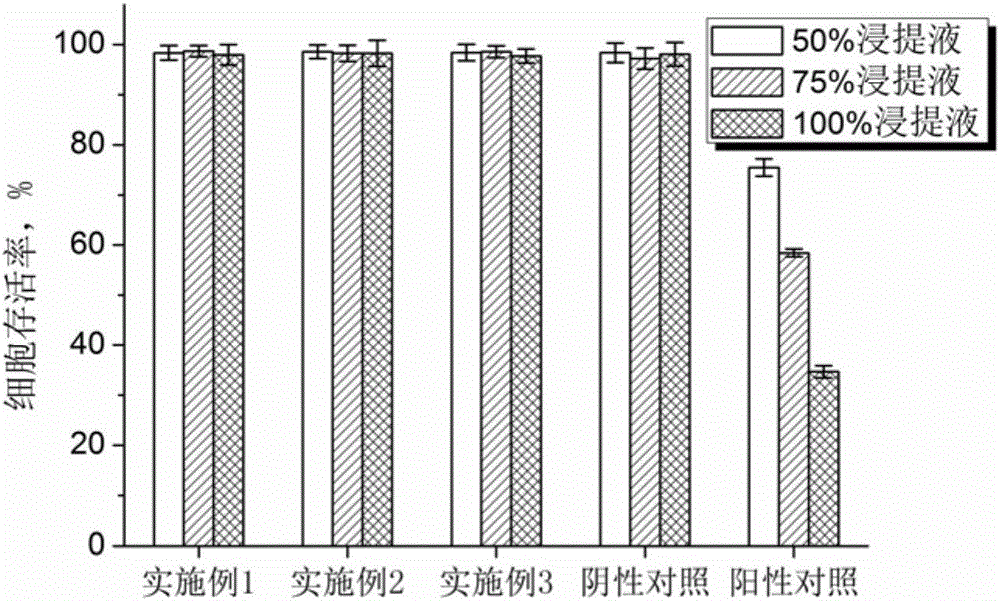Photocureable double-layer polysiloxane supra-molecular elastomer dressing for chronic skin wounds and preparation method of dressing
A supramolecular elastomer, polysiloxane technology, applied in pharmaceutical formulations, medical science, bandages, etc., can solve problems such as increasing nursing workload, aggravating patient pain, etc., to accelerate wound healing, resist bacterial infection, and promote growth. and regeneration effect
- Summary
- Abstract
- Description
- Claims
- Application Information
AI Technical Summary
Problems solved by technology
Method used
Image
Examples
Embodiment 1
[0056] Embodiment 1: a kind of skin wound dressing (BLF) with double-layer structure based on polysiloxane supramolecular elastomer 46 ) preparation:
[0057] (1) Synthesis of terminal hydrogen polysiloxane (PHMS): at room temperature, in a reaction kettle equipped with mechanical stirring, 1,1,3,3-tetramethyldisiloxane (300g) and octamethyl Cyclotetrasiloxane molar ratio HMM: D 4 = 1:15 feed, then add the equivalent of D 4 Sulfuric acid with a mass of 2% and a concentration of 80wt%. After stirring the reaction at room temperature for 20 h, separate the lower sulfuric acid phase with a separatory funnel, and use excess NaHCO 3 The residual sulfuric acid in the product was neutralized, and the crude product obtained after vacuum filtration was distilled under reduced pressure at 160° C. for 3 h to obtain the purified PHMS.
[0058] (2) Ester-terminated polysiloxane (PDMS-tBMA 2 ) synthesis: in the reaction kettle equipped with reflux condenser, nitrogen protection device ...
Embodiment 2
[0064] Embodiment 2: a kind of skin wound dressing (BLF) with double-layer structure based on polysiloxane supramolecular elastomer 30 ) preparation
[0065] (1) Synthesis of terminal hydrogen polysiloxane (PHMS): at room temperature, in a reaction kettle equipped with mechanical stirring, 1,1,3,3-tetramethyldisiloxane (300g) and octamethyl Cyclotetrasiloxane molar ratio HMM:D 4 = 1:10 feed, then add the equivalent of D 4 Sulfuric acid with a mass of 3% and a concentration of 86wt%. After stirring the reaction at room temperature for 20 h, separate the lower sulfuric acid phase with a separatory funnel, and use excess NaHCO 3 The residual sulfuric acid in the product was neutralized, and the crude product obtained after vacuum filtration was distilled under reduced pressure at 160° C. for 3 h to obtain the purified PHMS.
[0066] (2) Ester-terminated polysiloxane (PDMS-tBMA 2 ) synthesis: in the reaction kettle equipped with reflux condenser, nitrogen protection device an...
Embodiment 3
[0072] Embodiment 3: a kind of skin wound dressing (BLF) with double-layer structure based on polysiloxane supramolecular elastomer 16 ) preparation
[0073] (1) Synthesis of terminal hydrogen polysiloxane (PHMS): at room temperature, in a reaction kettle equipped with mechanical stirring, 1,1,3,3-tetramethyldisiloxane (300g) and octamethyl Cyclotetrasiloxane molar ratio HMM:D 4= 1:5 feed, then add the equivalent of D 4 Mass 4% concentration is 90wt% sulfuric acid. After stirring the reaction at room temperature for 20 h, separate the lower sulfuric acid phase with a separatory funnel, and use excess NaHCO 3 The residual sulfuric acid in the product was neutralized, and the crude product obtained after vacuum filtration was distilled under reduced pressure at 160° C. for 3 h to obtain the purified PHMS.
[0074] (2) Ester-terminated polysiloxane (PDMS-tBMA 2 ) synthesis: in the reaction kettle equipped with reflux condenser, nitrogen protection device and constant pressur...
PUM
 Login to View More
Login to View More Abstract
Description
Claims
Application Information
 Login to View More
Login to View More - R&D
- Intellectual Property
- Life Sciences
- Materials
- Tech Scout
- Unparalleled Data Quality
- Higher Quality Content
- 60% Fewer Hallucinations
Browse by: Latest US Patents, China's latest patents, Technical Efficacy Thesaurus, Application Domain, Technology Topic, Popular Technical Reports.
© 2025 PatSnap. All rights reserved.Legal|Privacy policy|Modern Slavery Act Transparency Statement|Sitemap|About US| Contact US: help@patsnap.com



